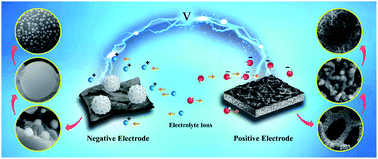Direct fabrication of phosphorus-doped nickel sulfide and eco-friendly biomass-derived humic acid as efficient electrodes for energy storage applications†
Abstract
Development of renewable energies is in parallel with improving high-performance energy storage devices, which can store maximum solar or wind energy and power. Herein, asymmetric energy storage systems are constructed from phosphorus-doped nickel sulfide (P-doped NiS) and biomass-derived humic acid (HA) as positive and negative electrodes, respectively. Initially, nickel sulfide (NiS) nanostructures are directly grown onto nickel foam (NF) via a hydrothermal step. P-doping into the NiS bulk is carried out through a simple hydrothermal process as well. Also, HA is activated via carbonization treatment (A-HA) for employing as the negative electrode's active material. The P-doped NiS–NF delivers a considerable specific capacity of 486.7 mA h g−1 at 6 A g−1 and the A-HA–NF exhibits a specific capacitance of 163.3 F g−1 at 0.1 A g−1. The assembled asymmetric supercapacitor (ASC) benefits from a wide operating potential window (1.6 V), remarkable energy density (36.32 W h kg−1), and reasonable power density (199.95 W kg−1). The promising electrochemical behavior endows the ASCs with significant applications in electrochemical energy storage systems.

- This article is part of the themed collection: Sustainable Energy & Fuels Recent HOT Articles


 Please wait while we load your content...
Please wait while we load your content...